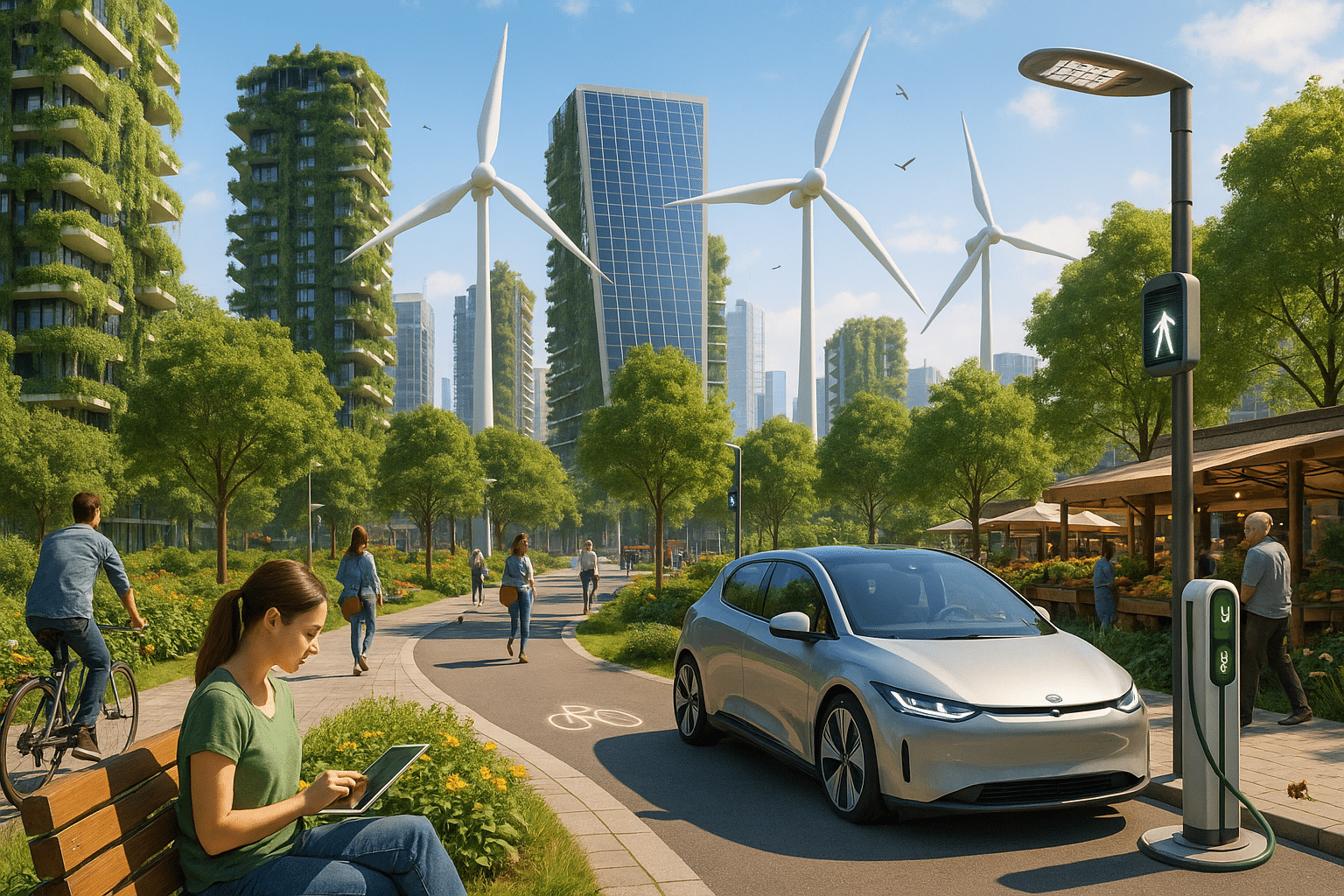A highly promising solution lies at the intersection of technology and sustainability: The Greening of the Future through Digital Transformation.
As we find ourselves in the midst of the Fourth Industrial Revolution, characterized by a fusion of technologies blurring the lines between the physical, digital, and biological spheres, we are offered a unique opportunity to drive sustainability. This digital transformation is not merely about environmental considerations, it’s about creating a sustainable future, where economy, society, and environment co-exist and nurture each other. 💡
But how exactly does digital transformation pave the way for a more sustainable world? What potential does it hold in reversing the damage done and preventing further harm? These are some of the questions this comprehensive article aims to address.
Deciphering Digital Transformation: A Sustainability Catalyst 🚀
The term “Digital Transformation” refers to the integration of digital technology in all areas of a business or society, fundamentally changing how you operate and deliver value. It’s not just about replacing old technologic infrastructure with new ones, but a cultural change that requires organizations to continually challenge the status quo, experiment often, and get comfortable with failure.
When applied to sustainability, digital transformation can be seen as a powerful tool that enables companies, individuals, and governments to achieve their environmental objectives more efficiently and effectively.
Unveiling the Synergy of Digital Transformation and Sustainability 🌿
Today, digital transformation and sustainability are two sides of the same coin. The combination of advanced technologies such as Artificial Intelligence (AI), Internet of Things (IoT), Cloud Computing, and Big Data not only drives business growth but also empowers sustainable practices.
From smart homes that conserve energy to precision agriculture that optimizes resource usage, digital transformation is driving sustainability in diverse sectors. This article will explore various realms in which digital transformation is making significant strides towards greening our future.
Anticipating the Future: The Role of Digital Transformation in Sustainable Development 🏭
The fusion of digital transformation and sustainability holds the promise of a more equitable and sustainable world. However, achieving this requires comprehensive understanding, strategic planning, and collaborative effort.
This article seeks to illuminate the numerous ways in which digital transformation influences sustainable practices and how these advancements can be harnessed to create a brighter and greener future.
So, get ready to embark on an enlightening journey as we delve into the captivating world of digital transformation and its crucial role in driving sustainability in the modern world. 💫
Driving Sustainability Through Digital Transformation: Setting the Scene
As we navigate the twenty-first century, we are witnessing a revolutionary fusion of technology with our daily lives. What’s more fascinating is how this digital transformation isn’t just reshaping our lifestyles, but it’s also paving the way for sustainable development across sectors. There’s no denying that the integration of digital technologies is setting the stage for a green future, and in this article, we’re going to explore just how that’s happening.
Before we dive in, let’s take a moment to understand the relationship between digital transformation and sustainability. While digital transformation refers to the integration of digital technology into all aspects of a business or society, sustainability is a broader concept that involves meeting our current needs without compromising the ability of future generations to meet theirs.
However, these two concepts aren’t mutually exclusive. In fact, they’re more intertwined than ever. Digital transformation can drive sustainability by creating efficiencies, reducing waste, and promoting responsible consumption and production.
The Role of Digital Transformation in Achieving Sustainable Goals
Digital transformation can act as a catalyst for sustainability in numerous ways. From energy consumption to waste management, digital technologies can optimize processes and reduce environmental impact.
For instance, consider the role of Artificial Intelligence (AI) and Internet of Things (IoT) in managing energy usage in buildings. By intelligently controlling heating, cooling, and lighting based on occupancy and usage patterns, these technologies can significantly reduce energy consumption.
Similarly, digital technologies can enhance waste management by optimizing waste collection routes, reducing fuel consumption, and minimizing greenhouse gas emissions.
How Digital Transformation is Influencing Key Industries
Let’s delve a bit deeper and look at how digital transformation is driving sustainability in key industries.
The Manufacturing Industry
In manufacturing, digital technologies like AI, IoT, and digital twins are enabling predictive maintenance, reducing downtime, and minimizing waste. Moreover, these technologies can help in designing products for longevity, reuse, and recycling, promoting a circular economy.
The Agriculture Industry
In agriculture, digital technologies like remote sensing, precision farming, and blockchain are transforming the way food is grown, harvested, and distributed, reducing wastage and promoting sustainable farming practices.
The Energy Industry
In the energy sector, digital technologies like smart grids and renewable energy management systems are optimizing energy generation, distribution, and consumption, promoting clean and sustainable energy.
Unveiling the Interlinkages: Digital Transformation and Sustainability
As we’ve seen, digital transformation can drive sustainability in multiple ways across various industries. But how do these interlinkages actually work? Let’s take a closer look.
The key lies in data. By collecting and analyzing data, digital technologies can provide insights that can be used to optimize processes, reduce waste, and make informed decisions. This not only enhances efficiency but also promotes sustainability.
For instance, by using data collected from smart meters, utility companies can optimize energy distribution, reduce power outages, and promote energy conservation. Similarly, by using data from GPS-enabled devices, waste management companies can optimize collection routes, reduce fuel consumption, and minimize emissions.
Case Study: Digital Transformation Driving Sustainability
To truly understand the impact of digital transformation on sustainability, let’s take a look at a real-world case study.
Enel: Pioneering a Sustainable Future Through Digital Transformation
Enel, an Italian multinational energy company, is pioneering a sustainable future through its digital transformation journey. By leveraging digital technologies like AI, IoT, and big data analytics, Enel is optimizing its energy generation and distribution processes, reducing emissions, and promoting renewable energy.
For instance, through its smart grid initiative, Enel is improving energy efficiency, reducing power outages, and facilitating the integration of renewable energy sources. Moreover, by leveraging big data analytics, Enel is predicting energy demand, optimizing energy supply, and reducing energy wastage.
Watch the YouTube video “Enel’s Digital Transformation Journey” from the Enel Group channel to learn more about their initiatives.
Challenges and Opportunities in Fusing Digital Transformation with Sustainability
While digital transformation can drive sustainability, it’s not without its challenges. These include data privacy and security issues, technological and infrastructural barriers, and the digital divide.
However, these challenges also present opportunities for innovation and improvement. By addressing these issues, we can not only enhance digital transformation but also promote sustainability.
Furthermore, digital transformation presents opportunities for sustainable growth. By integrating digital technologies with sustainability, businesses can create value, enhance competitiveness, and contribute to a sustainable future.
Conclusion
As we’ve seen, digital transformation is not just about integrating technology into our lives or businesses. It’s also about using that technology to drive sustainability and create a better future for us all.
As we continue to navigate the digital revolution, let’s keep in mind the potential of digital transformation to drive sustainability. After all, our future depends on it.
To learn more about how digital transformation can drive sustainability, watch the YouTube video “Digital Transformation for Sustainability” from the Accenture channel.

Conclusion
In conclusion, the main elements we have covered in this article are the foundational aspects of software engineering and the critical role it plays in the modern digital world. The various paradigms of software engineering, including the Agile model, the Waterfall model, and the V-model, each with their unique strengths and features, have been discussed in detail. These methodologies are the backbone of any successful software project, and choosing the appropriate model for your project can significantly impact its outcome.
We delved into the intricate world of coding, examining different languages and their applications. From Java to Python, C++ to Swift, each programming language has its own set of advantages, making it suitable for different kinds of projects. As we explored, choosing the right language is a critical factor in the success of a software project.
We’ve also uncovered the importance of testing in software engineering. Testing is not just a final step but an integral part of the software development lifecycle, ensuring the final product is bug-free and meets the user’s expectations. It provides the backbone for continuous improvement, ensuring software quality and customer satisfaction.
Moreover, we have looked into various software tools and how they can streamline and automate the software development process. Tools such as integrated development environments (IDEs), project management tools, version control systems, and automation testing tools are pivotal in maintaining efficiency in the software engineering landscape.
In summary, software engineering is an intricate, layered, and fascinating field that continually evolves and shapes the way we interact with the world. Its importance cannot be understated in today’s digital age.
If you’ve found value in this content, I invite you to share it with your colleagues or comment below with your thoughts. I’d also encourage you to apply the concepts we’ve discussed in your future software projects and observe the results. Feel free to delve further into the subject by exploring resources such as the IEEE Xplore Digital Library and ACM Digital Library.
Let’s continue this journey of learning, improving, and innovating together in the realm of software engineering. 😊👩💻🌍
This article is based on the following sources: IEEE Computer Society Digital Library, ScienceDirect, and ACM Digital Library.
Thank you for reading! 👏🏼👏🏼👏🏼



